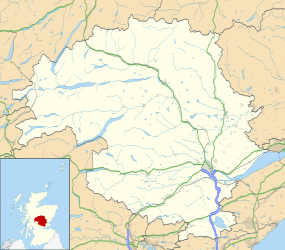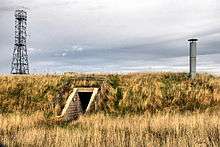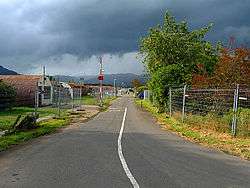Cultybraggan Camp
| Cultybraggan Camp | |
|---|---|
| Comrie | |
|
Entrance to Cultybraggan Camp | |
 Cultybraggan Camp Location within Perth and Kinross | |
| Coordinates | 56°21′20″N 03°59′39″W / 56.35556°N 3.99417°WCoordinates: 56°21′20″N 03°59′39″W / 56.35556°N 3.99417°W |
| Type | Barracks |
| Site information | |
| Owner | Ministry of Defence |
| Operator |
|
| Site history | |
| Built | 1941 |
| Built for | War Office |
| In use | 1941-2004 |
Cultybraggan lies close to the village of Comrie, in west Perthshire. It was first used as a prisoner of war (PoW) camp during World War II, and then became an Army training area. It later housed a Royal Observer Corps (ROC) nuclear monitoring post, and a Regional Government Headquarters (RGHQ).[1]
The camp ceased to be used by the military in 2004, and now belongs to the Comrie Development Trust, bought through a community right-to-buy option for £350,000 in 2007.[2]
Some of the original 100 Nissen huts on the western side of the camp were demolished in the 1970s to make way for a firing range, but the majority remain. The surviving huts, together with an assault course and modern Officers' Mess facility, make Cultybraggan "one of the three best preserved purpose-built WWII prisoner of war camps in Britain".[3] In 2006, a number of structures at the camp were listed by Historic Scotland. Huts 19, 20, and 44–46 are category A listed as being of national significance,[3] while huts 1-3, 21, 29-39, and 47-57 are category B listed.[4]
World War II

Named PoW camp No 21, built in 1941 to house 4,000 Category A prisoners, Cultybraggan was a 'black camp', holding those considered the most committed and fanatical Nazi PoWs, mainly young Waffen-SS, Fallschirmjäger and U-boat crew.[5] Army, Navy, Air Force and SS prisoners were held in separate compounds, as were the officers. An additional camp was located at Cowden, two miles distant.[1]
Ringleaders of the Devizes plot — to break as many as 250,000 PoWs out of camps across the country in 1944 and attack Britain from within — were sent to Camp 21 at Comrie. These included Feldwebel Wolfgang Rosterg,[6] a known anti-Nazi who was sent by mistake. He was lynched, and five of the prisoners were hanged at Pentonville Prison for his murder, the largest multiple execution in 20th-century Britain.[5]
Amongst the prisoners was Heinrich Steinmeyer, a former member of the Waffen SS, who was captured in Normandy in August 1944. He died in 2014 and left a bequest of £384,000 to the village which has been put into the Heinrich Steinmeyer Legacy Fund.[7]
Post war
Following the war, in 1949, Cultybraggan was opened as a training camp. It was used by the Regular Army, the Territorial Army and was popular with Cadet units for their annual camps. The camp covered some 8 acres (3.2 ha) and could accommodate 600 personnel in a mixture of huts and tents. Units rotating through the camp enabled 80,000 'man training days' of military exercising, including adventure training, cross-country driving, and helicopter operations, using the 12,000 acre Tighnablair Training Area, leased from the Drummond Estate.[1]
Cold War

As part of the Cold War defence of the nation, an underground Royal Observer Corps (ROC) monitoring post was installed in 1960. Although it closed in September 1991, when the ROC was stood down, it is still accessible.[8]
In 1990, an underground Regional Government Headquarters (RGHQ) bunker was completed in the north east corner of the camp site to replace the Scottish North Zone Headquarters bunker at Troywood (Anstruther). In the event of war, the Secretary of State for Scotland, the BBC, British Telecom, and other important organisations would have operated from here. However, the Cold War threat receded almost as soon as the bunker was completed, and the £3.6 million, two storey, underground structure was declared obsolete, and closed. Sold to the Army, the bunker was added to the military training facilities.
Comrie Development Trust
Since taking ownership of the 90-acre (36 ha) site on 20 September 2007, the Comrie Development Trust’s Cultybraggan Working Group have been working towards the sustainable development of this community asset. Major infrastructure works (drainage, electricity, water and telecoms), the conversion of nine Nissen huts to make 12 units for local businesses and the refurbishment of the central mess are included in the first phase. In 2012 it was reported that a communications firm had purchased the underground bunker at Cultybraggan for use as a "digital safe house".[9] However, the bid failed and the bunker was put back on the market.[10] In April 2014, the bunker was sold at auction to a service provider who are looking to use it for long term data and media storage.[11]
Future development plans for Cultybraggan include:
- Sports and recreation facilities;
- A ‘Back to the Futures’ Centre highlighting local history and plans for a low carbon future;
- Biomass Heat plant – Solar PV farm – Anaerobic digestion plant;
- Green Tourism;
- Renewable energy sources for the site and village;
- Footpath and cycle ways to the site; and
- Biodiversity areas and woodland planting.
References
- 1 2 3 "Cultybraggan". Secret Scotland. Retrieved 14 June 2011.
- ↑ "New history of Cultybraggan POW camp produced". STV. 14 April 2010. Retrieved 14 June 2011./
- 1 2 "Cultybraggan Former Cadet Camp, Huts 19 and 20 (Guard's Block) and 44, 45, 46: Listed Building Report". Historic Scotland. Retrieved 29 May 2012.
- ↑ "Cultybraggan Former Cadet Camp, Huts 1-3, 21, 29-39, 47-57 (all nos inclusive): Listed Building Report". Historic Scotland. Retrieved 29 May 2012.
- 1 2 "Prisoner Of War Camps In Devizes During World War II". Devizes Heritage. Retrieved 14 June 2011.
- ↑ "The Case of Feldwebel (Sergeant-Major) Wolfgang Rosterg". Retrieved 16 December 2014.
- ↑ "Former Nazi storm trooper donates life savings to Scottish village where he was held captive". Daily Telegraph. Retrieved 3 December 2016.
- ↑ "Cultybraggan Army Training Camp, Comrie, Perthshire 19/01/08". 28dayslater - The UK UE Urbex Urban Exploration Forums. Retrieved 14 June 2011.
- ↑ "Lincoln firm buys Cultybraggan nuclear bunker". BBC News. 31 January 2012.
- ↑ Perth & Kinross Courier
- ↑ "Tech firm Bogons buys Cultybraggan nuclear bunker". BBC News. 21 May 2014.
External links
- Cultybraggan, Comrie Development Trust
- Cultybraggan RGHQ, Subterranea Britannica
